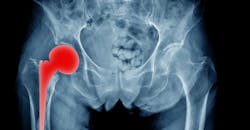Study Finds 60% of Hip Implants Last 25 Years
After reviewing thousands of case studies going back 25 years across six countries, researchers at the University of Bristol say they indicate that eight out of 10 total knee replacements (TKRs) and six out of 10 total hip replacements (THEs) will still be in place after 25 years. Despite doing more than two million hip and knee replacements over the past 16 years, British doctors were unable to give patients a fact-based estimate of how long they might last. Previous studies have been based on much smaller samples. At best, UK doctors could only tell patients how long replacements were designed to last, rather than referring to actual evidence from patients’ experiences of joint replacement surgery.
Hip and knee replacements are two of the most common and effective forms of surgery. Yet even in the best-case scenarios, they will ultimately fail due to infections, fractures, normal wear-and-tear, and reactions to wear particles. In many of these cases, patients require revision surgery which is more prone to failure, associated with recoveries, and more expensive than primary surgery.
Knowing how long a hip or knee replacement is likely to last is therefore key for patients and orthopedic surgeons when deciding whether surgery should be done and when. This will become increasingly relevant to more people given the longer life expectancy of the growing population.
Hip replacements principally consists of two components, one that replaces the ball and another that replaces the socket. There is variation in how these parts are fixed to the bone, as well as in the materials used to create the bearing (contact) surface. There are two main types of knee replacement. A total knee replacement (TKR) replaces all of the patient’s joint surfaces whereas a unicondylar knee replacement (UKR) only replaces the damaged part of the knee. There is considerable variation in how long different designs of hip and knee replacements last, and these factors were accounted for in Bristol’s study.
A total of 150 cases were reviewed relating to hip replacements and 33 relating to knee replacements, as well as six national joint replacement registries (large databases of all patients who have had a joint replacement) from Australia, Denmark, Finland, New Zealand, Norway, and Sweden—countries with more than 15 years' worth of data. This let the overall study look at 215,676 people whose cases were followed up for 15 years after undergoing total hip replacements; 74,052 who were followed up for 20 years; and 51,359 who were followed up for 25 years. The UK was not included because of the lack of national-level data for 15 years or more. However, current study results agreed with those of smaller UK studies.
Of the total hip replacements, 89% were found to last 15 years, 70% lasted 20 years, and 58% lasted 25 years.
With total knee replacements, the 15-year results related to 299,221 people who had total knee replacements (TKRs) and 7,714 who had unicondylar, or partial, knee replacements (UKRs); 20-year results related to 88,532 TKRs and 3,935 UKRs; and the 25-year data related to 76,651 TKRs and 3,935 UKRs.
Fully 93% of TKRs and 77% of UKRs lasted 15 years. Ninety percent of TKRs and 72% UKRs lasted 20 years. Eighty-two percent of TKRs and 70% of UKRs were seen to last 25 years.
Most male and female patients who underwent THR were, on average, 70 and 68 years of age, respectively, with an average body mass index (BMI) of about 28.8.
National registry data included over 200 000 THR at 15 years, about 73 000 at 20 years, and over 51 000 at 25 years.
The survival outcomes for total hip replacements were impressive: Almost nine out of 10 lasted 15 years, seven out of 10 were in place at 20 years, and almost six out of 10 at 25 years.
Additionally, more than 13 000 THR from 44 case series were analyzed in parallel. The survivorship figure in this case was similar at 15 years, but almost eight out of 10 implants survived at 20 years and 25 years, respectively.
With respect to knee replacements, the survival rates were also very good: for total knee replacement, the function was maintained in 93% cases after 15 years, 90% after 20 years, and 82% after 25 years. For partial knee replacements, the corresponding figures were 77%, 72%, and 70%.
Factors which affect the survival of a THR include age, sex, and type of implant. Trends in health service delivery have also changed a lot, as has implant material, structure, and design. Given the improvement in technology and techniques in the last 25 years, it is expected that hip and knee replacements put in today will last even longer.

